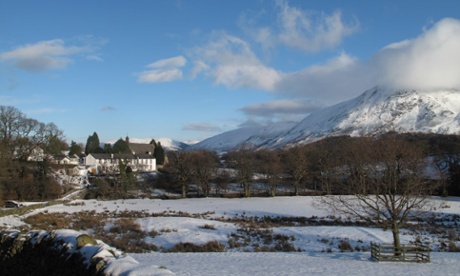
Coming up the steep ascent I start to zigzag, blowing hard. The early mist is clearing and sunshine breaks around the corner of the mountain. A grouse chuckles nearby in the heather. Then, suddenly, I am at 500 metres and on the top, gazing out over a vast panorama of lakes and mountains. Far to the west is a golden smudge of sea and, even as I stand there, the sky is clearing, patches of blue joining hands over Buttermere and out beyond Scafell Pike. I take a panoramic shot with my phone and tweet it. Within a minute I get a text back from a friend: “It’s raining here.”
Further along the ridge, the view is down into Crummock Water, the entire lake a dappled mirror of russet and gold. The air is utterly still and clear. “Where are you?” comes a second text.
I send another pic. “The Lakes.” I look at the photo with its blue skies and alpine clarity of light and add: “In winter.”
Most people just don’t bother. January to March are by far the quietest times in the Lakes, as you might expect. There is a 50% chance of rain or snow on any day, and a lot less daylight – seven hours, if you’re lucky. I’ve been there when the roads have flooded, when snow has blocked passes, when you would not want to send a dog outside. But I love it.
Let’s start with the night before that walk. As I drive up over Honister Pass, a dark sheet of cold cloud squeezes a thin bronze bar of fading light across Fleetwith Pike. In the headlamps, a torrent of rainwater and dead leaves is coming down the road. Then I drop into Lorton Vale and somehow get lost in pitch darkness in the wiggly lanes between Crummock Water and Loweswater. I am searching for the Kirkstile Inn, a place I want to find for no better reason than they make, and sell, the best beer in the world. No wait, I don’t want to be falsely accused of hyperbole, best beer in the universe. It’s called Loweswater Gold. I had it once before at a beer festival and have pined for it ever since.
I find the place, eventually: a solid black-and-white farmhouse under the looming presence of Melbreak fell, a 512-metre midget that, in the gloaming, has the look of a giant volcanic monster. There is a fire in the inn’s bar, live music, roast lamb off the fell, and – heaven – Loweswater Gold by the barrel. You need to walk in from the cold, from the savage gloom, to appreciate these things. Summer just doesn’t compare.
Next day, coming down off the eastern end of Melbreak, I explore Scale Force, the highest waterfall in the Lakes. Between May and October, it’s nothing but a pathetic mossy dribble – and it’s not always that impressive in winter either, to be honest. Then I go down alongside Crummock Water where there is a moment of perfection: warm sun, the lake all golden, no sound at all, and no one else around.
And what if the weather is just too horrible, as it is the following day? I drive over to Keswick and spend a couple of hours climbing at the brand new King Kong Climbing Centre (adult from £7, child £4.50). Don’t be put off by the childish name: this has some serious indoor climbs, plus a cave, an ice climb and a place to leave the kids while you try it all out. At least it keeps me away from the camping and climbing shops – normally I can’t resist and the town has a wonderful array. And if you really want outdoor climbing, there’s always the new Via Ferrata Xtreme at Honister – open all year.
From Keswick, I head across to Bassenthwaite Lake, where Paul Currie has just opened the Lakes Distillery (tour £12.50), the first whisky distillery here for a century – well, the first official one, as there were a few distinguished but highly illegal operations in the past.
It’s a lovely spot and Paul is an enthusiast: he cut his teeth by opening a distillery on the Isle of Arran with his father 20 years ago. He spotted this derelict farm where the Derwent river comes charging out of Bassenthwaite.
“I had the water tested and found it was perfect for whisky,” he says, “I couldn’t resist giving it a try.”
I nod sympathetically: I always have that same feeling about whisky.
The giant copper stills are already humming, sending out delicious warm aromas, as will the restaurant soon enough: they are just putting the finishing touches to it when I visit.
Outside, the temperature is dropping and I know what I want: a steam room or a hot tub. I drive over to Langdale, savouring the lack of traffic jam on the road past Wordsworth’s cottage in Grasmere. In summer, this stretch of road can be a solid line of cars. Even Ambleside is a pleasure: there are parking spaces in the street, a thing rarer than hen’s teeth between May and October. Then it’s into the spa complex at the Langdale Hotel.
Thoroughly warmed up, I walk through the rain to Elterwater village and the Britannia Inn. The only thing that has changed here in the past 40 years appears to be the firewood and the barrels. In front of the fire, I settle down with a pint of Bluebird Bitter from the Coniston Brewing Company; it’s not Loweswater Gold, but second-best in the universe is still pretty good.
• The trip was provided by the Cumbria tourist board, golakes.co.uk. The Kirkstile Inn (01900 85219, kirkstile.com) offers half-board from £59.50pp pn until 26 March (two-night minimum). Langdale Hotel & Spa (015394 38053, langdale.co.uk) has doubles from £155 B&B spa free to guests, day passes from £10 Mon-Thur, £15 weekends

